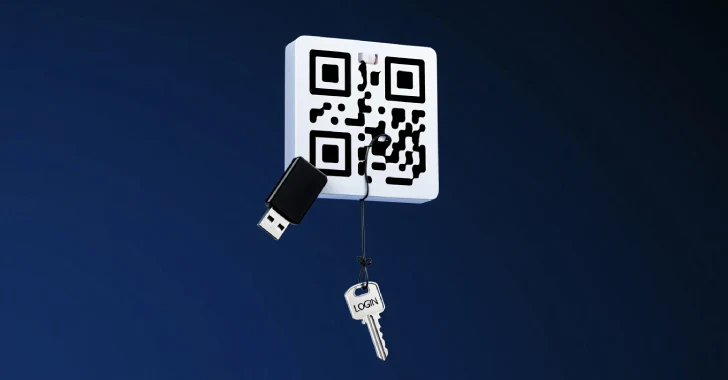
PoisonSeed Hackers Bypass FIDO Keys Using QR Phishing and Cross-Device Sign-In Abuse
The promise of strong, phishing-resistant multi-factor authentication (MFA) often rests on technologies like FIDO keys. Yet, even the most robust security mechanisms can be bypassed through sophisticated social engineering. A recent advisory from cybersecurity researchers highlights a concerning new attack vector: Threat actors, dubbed “PoisonSeed,” are actively exploiting QR code-based phishing and cross-device sign-in loopholes to circumvent FIDO key protections. This development underscores the critical need for organizations to understand the evolving threat landscape and fortify their defenses beyond traditional MFA.
The PoisonSeed Modus Operandi: QR Phishing Meets FIDO Bypass
Research from Expel has pulled back the curtain on the PoisonSeed group’s novel attack methodology. Their technique centers on a deceptive process that tricks users into inadvertently approving authentication requests on spoofed company login portals. Unlike classic phishing attempts that simply steal credentials, PoisonSeed’s approach aims to leverage legitimate FIDO key interactions against the user.
The core of the attack chain involves:
- Building highly convincing, brand-impersonating login pages that mimic legitimate company portals.
- Employing QR code-based phishing, a growing trend, to initiate the authentication flow. Users are prompted to scan a QR code, often under the guise of “confirming identity” or “expediting login.”
- Exploiting cross-device sign-in mechanisms. When the user scans the QR code, their FIDO-enabled device (e.g., a smartphone or hardware security key) is instructed to authenticate against the attacker’s controlled, spoofed portal, effectively bypassing the FIDO key’s inherent protection against phishing the origin.
This method circumvents FIDO’s primary strength: its ability to bind authentication to a specific origin (website). By tricking the user’s device into authenticating with the malicious site through a seemingly legitimate process, PoisonSeed can effectively hijack the FIDO key’s approval.
Understanding FIDO Key Strengths and This Novel Bypass
FIDO (Fast IDentity Online) keys, including U2F and WebAuthn standards, are lauded for their phishing resistance. They achieve this by generating unique cryptographic keys tied to the specific domain a user is authenticating with. If a user is on a spoofed domain, their FIDO key will technically refuse to authenticate, as the cryptographic challenge won’t match the expected origin. However, PoisonSeed’s innovation lies in its ability to manipulate the user into initiating a legitimate-looking cross-device authentication with the spoofed domain, rather than directly phoning home to a malicious server.
The key exploit here is the abuse of the cross-device sign-in flow. When a user scans a QR code generated by the attacker, their FIDO-enabled device “sees” a request to authenticate with the attacker’s server, which is designed to mimic the legitimate service. Because the interaction happens at a protocol level through the FIDO client on the user’s device, the typical domain-binding protection is circumnavigated so long as the user’s device is tricked into initiating the connection to the attacker’s “authentic-looking” server.
Remediation Actions and Mitigations
Organizations and individual users must adopt a multi-layered approach to defend against sophisticated attacks like those perpetrated by PoisonSeed. While there is no specific CVE tied to this social engineering technique itself, the underlying principles often leverage misconfigurations or user trust, similar to how CVE-2023-38545 (related to curl and libcurl HTTP proxy vulnerability that could be exploited) or CVE-2023-40113 (a privilege escalation vulnerability in Microsoft Windows) could be part of a broader attack chain.
- Enhanced User Education: Train employees to be extremely wary of QR codes accompanying login prompts, especially those received via email or unexpected channels. Emphasize verifying the legitimate domain in the browser’s address bar before interacting with any QR code or sign-in prompt.
- Implement Conditional Access Policies: Leverage Zero Trust principles. Use conditional access policies to restrict access based on device health, location, and user behavior. For instance, deny access from unusual geographic locations or unmanaged devices, even if a FIDO key is presented.
- Review FIDO Implementations: Ensure your FIDO implementation does not inadvertently allow for easy cross-device sign-in abuse. Work with your identity provider to understand how their cross-device authentication flows handle origin verification and if any settings can be hardened.
- Phishing Incident Response Drills: Conduct regular phishing simulations that include QR code-based scenarios to prepare users for real-world attacks.
- Endpoint Detection and Response (EDR) & Extended Detection and Response (XDR): Deploy robust EDR/XDR solutions to detect suspicious activity linked to initial access attempts or post-compromise lateral movement, even if the FIDO bypass is successful.
- Secure Browsing Habits: Encourage the use of browser extensions that enhance security by flagging suspicious URLs or enforcing HSTS (HTTP Strict Transport Security) on critical domains.
Relevant Security Tools and Resources
While no single tool can prevent all social engineering, combining powerful detection and security awareness platforms offers a robust defense.
| Tool Name | Purpose | Link |
|---|---|---|
| PhishMe (Cofense) | Security Awareness Training & Phishing Simulation | https://cofense.com/ |
| KnowBe4 | Security Awareness Training & Phishing Simulation | https://www.knowbe4.com/ |
| Microsoft Defender for Endpoint | Endpoint Detection & Response (EDR) | https://www.microsoft.com/en-us/security/business/endpoint-security/microsoft-defender-for-endpoint |
| CrowdStrike Falcon Insight XDR | Extended Detection & Response (XDR) | https://www.crowdstrike.com/products/falcon-platform/falcon-insight-xdr/ |
| Perimeter 81 (ZTNA) | Zero Trust Network Access (ZTNA) | https://www.perimeter81.com/ |
The Evolving Landscape of FIDO Bypass
The PoisonSeed campaign is a stark reminder that even the most advanced authentication technologies are not entirely immune to well-crafted social engineering and innovative attack vectors. The shift towards QR phishing and the exploitation of cross-device sign-in mechanisms demonstrate threat actors’ relentless pursuit of new ways to circumvent security controls. For cybersecurity professionals, the takeaway is clear: continuous evaluation of authentication flows, robust employee education, and a layered security posture are non-negotiable in the face of these emerging threats.





